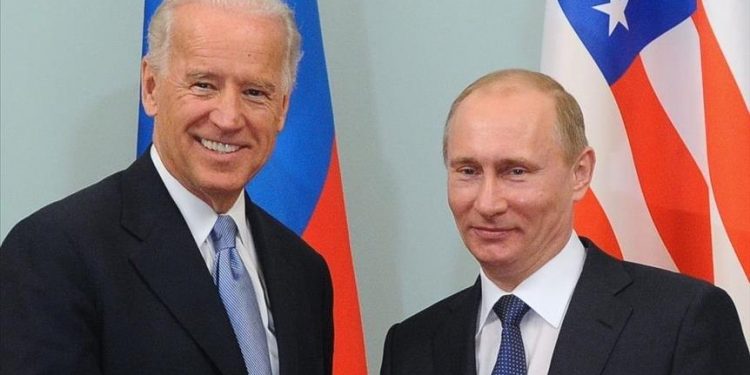Malay Mishra
Cold wars need not be symmetrical. They could vary with change in actors, circumstances and time. To assess the aftermath of the recent Biden-Putin summit meeting June 16 as a ‘cold peace’ or a full-fledged cold war in the making is immaterial. It is important to analyse the background against which it happened, the timing of the event and the principal actors involved in the coming together in person of the two leading powers. Remark that exactly 36 years ago the same venue, the 18th century Villa La Grange on Geneva lakeside, had hosted the historic Reagan-Gorbachev summit which ushered the US-Soviet cold war leading finally to the dismantlement of the Soviet empire with the US remaining the sole superpower, a position that it maintained until the early 1990s until the gradual advent of China.
The general assessment that the American president meant business and nearly accomplished the two-fold objective in his mission is realistic. These were reassuring its European allies that America was back and strengthening the badly-damaged Atlantic Alliance, and second, confronting Russia to address Europe’s (as well as its own) concerns while conveying a powerful sign to the world that America was now ready to regain its rightful place in the free world. In both Biden was largely successful. His posture as a seasoned statesman was at full play. He had asked for this meeting and wanted to meet his Russian counterpart even after calling him a ‘killer’ earlier this year and imposing a series of further sanctions, including sending a few Russian diplomats back to Moscow. This had triggered the return of the two ambassadors to each other’s capitals. Consequently, relations between the two powers had sunk to ‘the lowest point’ by the leaders’ own admission.
Both positives as well as negatives emanated from the summit. The positives included an agreement to restart the strategic nuclear talks abruptly called off by Trump, exchange ambassadors back and continue the dialogue process, while the major points of differences, with the US threatening ‘devastating consequences,’ were on alleged cyberattacks and attacks on US utilities (Biden listed 16 such utilities on which America drew the ‘red line’), interference in the 2016 and 2020 presidential elections, and the safety and life of Russian dissident Alexei Navalny. A few regional issues were also discussed.
Having met four American presidents after his coming to office in 2000 (Biden was his 5th), Putin, the versatile judo player, had to first play defence and then hit the opponent as the rules of the game provide. He did exactly that. While denying all charges of Russian intelligence agencies spying in America’s elections he counter-charged that it was America rather which was indulging in cyber attacks on other countries. He also dismissed allegations of increasing dissent in Russia with the counter charges of interventionism of America’s foreign policy and domestic chaos in the country where he named the January 6 insurrection on the Capitol and rising Black American sentiments.
The three previous summits which Biden attended, the G-7, NATO and EU had exposed another adversary of America, China. The European allies had to play along though it was clear that there was lack of a broad consensus in aiming their guns at China with whom the major European powers have important technology, trade, business and investment ties. Besides geo-politically Russia is a bigger threat to Europe than China. Thus when the ‘Bring Back a Better World’ (BBBW) was discussed in the EU forum as a pushback against China’s BRI it did not have many takers. Comprehensive Agreement on Investment’s (CAI’s) ratification in the European Parliament has stalled because of increasing concerns at China’s human rights abuses in Xinjiang, Hong Kong, naval incursions in the Taiwan Strait and South and East China Seas as well as sanctions on persons and entities on both sides. The demand for further investigation into the origins of Covid-19 was an expected addition in which Biden received wholehearted support.
Despite both the American and Russian leaders calling each other ‘pragmatic,’ the US looking for a ‘predictable and stable’ relation with Russia could be hard to come by. Russia’s encroachment into the eastern region of Donbas and amassing huge number of troops on Ukraine’s south-eastern border have raised hackles in all European capitals though energy issues could still drive their relations further.
How does all of this play out for India? Note that there are three important summits lined up for later this year, the Quad Summit and the ‘Summit of Democracies’ in the USA and the BRICS Summit in Delhi. All three would see India taking positions on vital geo-political issues where interests diverge. The Quad grouping based on the US-led ‘international-rules based order’ has not found favour among important BRICS members, China and Russia. The ‘Summit of Democracies’ will take Delhi’s voice seriously as the largest democracy of the world. India had called itself ‘a natural ally’ of EU, defending ‘freedom of thought and expression’ and fighting authoritarianism, violence and repression.
It needs to be noted that barely a few days after the Summit, commenting on India’s human rights record, the Acting Assistant Secretary of State for South and Central Asia, stated, “Some of the Indian government’s actions have raised concerns that are inconsistent with India’s democratic values…” Two days later UNHRC Special Rapporteurs in a report raised concern about India’s recent IT rules not conforming to international human rights norms on right to privacy and freedom of expression. India’s close relations with both the USA and Russia could land the country in further difficulties. The Summit could have been the beginning of a long haul ahead.
The writer is a retired ambassador.







































